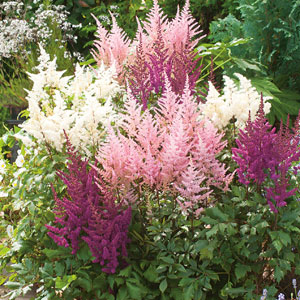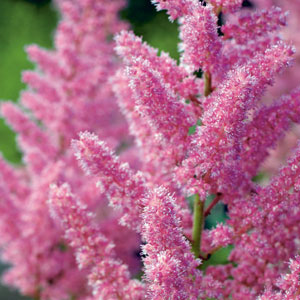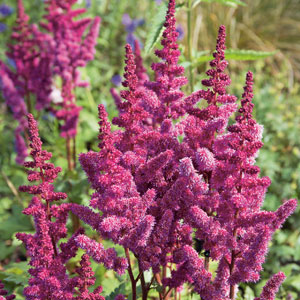Astilbe Growing Guide

What is Astilbe?
Astilbe (Astilbe hybrids) also known as False Spiraea or False Goats Beard is a rhizome-rooted herbaceous perennial. It is part of the Saxifragaceae family and is native to East Asia. There are more than 25 species of this plant available and there are hundreds of hybrid varieties. The rhizome sprouts compound leaves with many toothed leaflets which is glossy and fern like. These leaves will form a clumping habit. Late in Spring to early Summer striking long-stemmed plumes of tiny flowers appear with colours ranging from white to pale pink to rich purple to burgundy. When planting Astilbes prefer a part shade or dapple shaded position in the garden which reflects where they come from. In the wild, Astilbe is found in woodlands and mountain ravines, so it makes sense that it enjoys ample shade and moist (even boggy) conditions. It’s well-suited to waterside plantings, such as next to ponds. Astilbe naturalises and form clumps quickly, and can be left undisturbed for years.
Benefits of Growing Astilbe
Astilbe are excellent plants for a woodland style garden or planted alongside ponds. They will even be happily planted in a boggy site. Once these plants are established they spread quickly and form clumps. They also make very good cut flowers, lasting well in vases.
How to Grow Astilbe
Climatic Zones
Cool, temperate, arid, semi arid.
Plant Size
Height: 60-90cm, Width: 25 -40cm
When To Plant Astilbe
Plant in Winter.
Soil Preparation
Astilbe like moist, fertile soil that’s rich in humus, so prepare soil with lots of organic matter.
How To Plant Astilbe
Plant in part shade to full sun, 30cm apart with the plant crown at soil level. Water generously, and ensure the soil doesn’t dry out while the plant is establishing.
Astilbe Plant Care
Astilbe should be kept moist during the growing and flowering period. They do not tolerate dry soils.
Mulch to help keep the roots moist and cool.
Apply an annual feed of general purpose fertiliser once plant starts to shoot.
Once the plant has finished flowering, cut spent stems to ground level and remove dead leaves.
Divide plants every 3–4 years in Winter to maintain vigorous and quality flowering plants.
Pest resistant but can be affected by powdery mildew.
Recommended Astilbe Varieties
Given the right environment, this attractive ornamental plant contributes both colour and texture with minimal maintenance.










